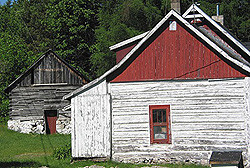
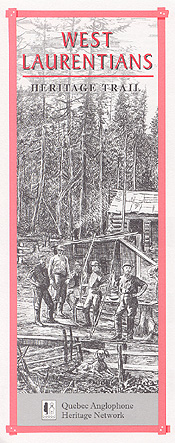
This heritage trail leads to historic settlements and pioneer landmarks between the Ottawa River and the Laurentian highlands.
American settlers founded a colony where the North River joins the Ottawa in about 1785. British homesteaders later put ashore here and walked north to land grants where today we find the communities of Lachute, Harrington, Lakefied, Morin Heights and Arundel.
St. Eustache was the gateway for French-speaking settlers who moved through Ste-Scholastique and St-Jérôme and up the North River in the 1840s and 1850s.
Thin soil, steep hills and bogs made farming difficult above the Ottawa plain. Logging was the chief industry north of Lachute by the late 1800s. However, scenic lakes and hills appealed to Montrealers.
When trains came in the 1890s, Laurentian villages found a new vocation: year-round hospitality for recreation-minded visitors.
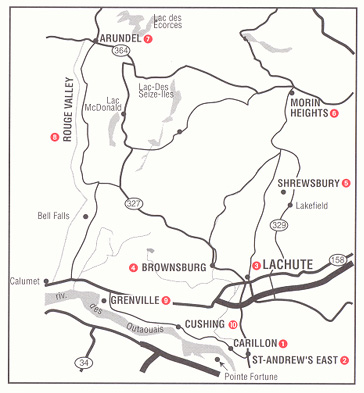 Enterprising families lodged guests in their farmhouses. Boarding houses sprang up. Around 1900, the first all-season hotels opened. Today the region is one of Quebec's leading holiday destinations.
Enterprising families lodged guests in their farmhouses. Boarding houses sprang up. Around 1900, the first all-season hotels opened. Today the region is one of Quebec's leading holiday destinations.
HOW TO GET THERE
From Montreal, Quebec City, the Eastern Townships or the New-England-Quebec border, drive to Aut. 40 and head west. Follow signs for Pointe-Fortune and ride the ferry across the Ottawa River.
CARILLON
Start exploring near the site of the Battle of Long Sault. In 1660 a small group of French, Huron and Algonquin soldiers led by Dollard des Ormeaux fought a large Iroquois army preparing to attack Montreal. Dollard’s party was defeated, but the Iroquois quit their campaign. Parks Canada maintains a monument here.
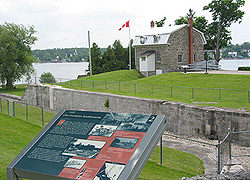 The Argenteuil Historical Society Museum shows the growth of the region in the 19th century. This building dates to 1820, when it served as quarters for British military engineers overseeing construction of canals on the Ottawa River.
The Argenteuil Historical Society Museum shows the growth of the region in the 19th century. This building dates to 1820, when it served as quarters for British military engineers overseeing construction of canals on the Ottawa River.
ST-ANDREWS EAST
This is one of the oldest villages in the Ottawa Valley. John Abbott, Canada’s first native-born prime minister, was born here. The stone gristmill built by Argenteuil Seigneur Patrick Murray in 1802 still stands on the west bank of the North River (Rivière du Nord).
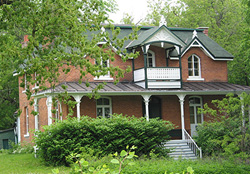 Heritage homes on rue de la Seigneurie recall the influence of New England and Scottish immigrants, as do the churches. St. Andrew’s Presbyterian on rue John Abbott dates to 1818; Christ Church Anglican on rue Long Sault (Route 344) dates to 1819.
Heritage homes on rue de la Seigneurie recall the influence of New England and Scottish immigrants, as do the churches. St. Andrew’s Presbyterian on rue John Abbott dates to 1818; Christ Church Anglican on rue Long Sault (Route 344) dates to 1819.
A plaque opposite the Anglican Church marks the site of Canada’s first paper mill, built by New Englanders in 1805. Now head north on Route 327.
LACHUTE (pop. 11,600)
This old mill town takes its’ name from a waterfall on the North River first noted by French map makers. Vermont families settled here in the 1790s. They were followed by a wave of immigrants from Scotland, including the Barrons, prominent landowners.
Streets in the historic district near the 1887 courthouse still bear the names of Barron family members, including Grace St. with its elegant brick homes. The stone Presbyterian Church on Main Street, built in 1833, preserves Lachute’s Scottish heritage.
The growth of mills in the late 1800s drew French Canadian workers to Lachute; today francophones make up two thirds of the population. Mills hug the river. Cross Barron’s Bridge and follow rue Princesse for a closer look.
The Ayers Woollen Mill, built by Thomas Ayers and Félix Hamelin in 1879, figured centrally in Lachute’s development. The company made wool blankets and felt sheets. Hundreds of workers lived in a nearby community called Ayersville. Note the ruins of a large stone Catholic Church on rue Princesse that the Ayers family built for their workers in 1935.
Irishman J.C. Wilson began a paper mill in 1887 now owned by Cascades. The striking mansion next to the factory, dubbed the Château, was the family estate.
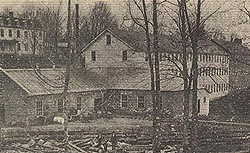 BROWNSBURG (pop. 2,555)
BROWNSBURG (pop. 2,555)
Those interested in military heritage may wish to visit this community, a few kilometres west of Lachute. During World War II the Dominion Cartridge plant on the West River employed thousands of workers to supply ammunition to Allied forces. Factory buildings dominate the town. Now double back toward Lachute and head north on Route 329.
SHREWSBURY PIONEER CHURCH AND CEMETERYTurn left off onto Shrewsbury Rd. Trees have overgrown the fields cleared by Irish homesteaders in the 1830s. Reach the deserted village crossroads a few kilometres from the highway. Where a general store, forge, Orange Hall, post office and school used to stand, this church alone (1858) is all that remains.*
*Note: This church was arsoned in 2014.
MORIN HEIGHTS (pop. 2,300)
The first farmer in Morin Heights was Thomas Seale, who settled on Echo Lake in 1848. Seale’s sawmill, the Argenteuil Lumber Company, operated for nearly a century till the 1960s. The old mill office, now a home, sits on rue du Village halfway up the hill; across the street stands the Mill Barn, where company horses were stabled.
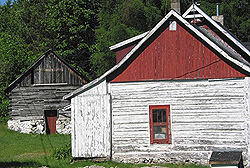 Morin Flats was named for Augustin Norbert Morin, a Quebec parliamentarian who joined Louis Joseph Papineau in 1834 to demand greater political autonomy from Britain. The Morin family house, built in 1860, stands directly opposite the post office and is now a drug store.
Morin Flats was named for Augustin Norbert Morin, a Quebec parliamentarian who joined Louis Joseph Papineau in 1834 to demand greater political autonomy from Britain. The Morin family house, built in 1860, stands directly opposite the post office and is now a drug store.
In 1911 Morin Flats changed its name to Morin Heights to appeal to tourists. The Bellevue Hotel on Lake Echo Rd. was a popular ski resort operated by the Basler family from Switzerland.
In the 1970s, storekeeper J.E. Seale’s family home on rue du Village became Rose’s Cantina, a famous folk-music venue popular with hippies. It’s now a daycare centre.
In nearby Christieville hamlet, the charming Ivall forge recalls a time when the ringing of a blacksmith’s hammer and anvil sounded the rhythm of country life.
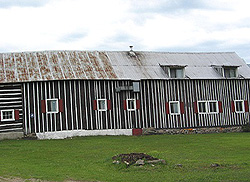 ARUNDEL (pop. 350)
ARUNDEL (pop. 350)
Time hasn’t dulled the frontier feel of this farm community flanked to the west by the Rouge River and a chain of lakes and hills to the east. English-born fur trader Stephen Jakes Bevin built a cabin here in 1822; Scotsman William Thompson became Arundel’s first colonist in 1857.
Driving north on Crystal Falls Road (Route 327) leads past the old Orange Lodge, a relic of early settlers’ staunchly Protestant roots. It’s now the Legion hall.
Further north, the Arundel Natural Science Center features an authentic square-timber farmhouse built in 1856. Just beyond, discover Knox Presbyterian Church, built in 1908 by Edmund Bennett and painstakingly restored in 2002. The church is all that remains of Crystal Falls, a rural community that once boasted a school and a cheese factory.
Returning to Arundel, a right turn onto chemin Henry leads to a vintage CNR train station, built in 1925 and recently restored as a post office. An imposing Victorian house with turret awaits travelers further down the road. Legendary country doctor Reginald Henry lived and practised here for 46 years till his retirement in 1967.
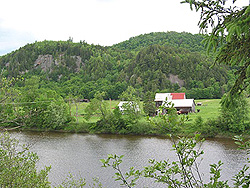 ROUGE VALLEY
ROUGE VALLEY
A breathtaking country road traces the famous Rouge River as it winds through old Harrington Township to join the Ottawa. Allow an hour for the drive. Some of the best farmland in the Laurentians lies in this valley, settled by Irish pioneers.
An old homestead near the Rouge Valley Pioneer Cemetery is now a Buddhist monastery.
When you reach Harrington United Church, turn right onto Harrington Rd. Rounding the bend at Bell Falls brings into view a scene from the 1920s: a clutch of old homes shaded by towering pines overlooking a bay. Park at the hotel and walk across the road to admire the falls before completing the rest of the trail.
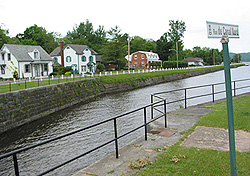 GRENVILLE VILLAGE (pop. 1,445)
GRENVILLE VILLAGE (pop. 1,445)
To glimpse a relic of canal life, veer off rue Principale (Route 344) in the direction of the river, west of the Hawkesbury bridge. A segment of the historic Grenville Canal survives intact, fronted by several period homes.
The six-mile-long canal was one of three built on the Ottawa River from 1819 to 1834 to provide British troops with an alternate waterway between Montreal and Kingston.
Directly opposite the large National Historic Monument, admire the wooden inn that Irishman John Kelley built in 1825 to accommodate the Royal Engineers. Now a private house, the building is a good example of traditional pièce-sur-pièce construction whereby finely hewn timbers are notched together and flushed on all sides to fit without chinking.
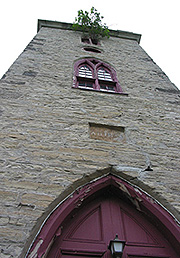 CUSHING
CUSHING
Lemuel Cushing, a Vermont native, grew wealthy during the peak of the Ottawa Valley timber trade. His legacy includes the magnificent Colonial house at the corner of Route 344 and Cushing Hill Rd (Montée Cushing). Built in 1826, it was a post office, a bank and, till recently, a general store. It’s now a private home.
Just east of this site, set back off the road, old St-Giles Church rises among the trees. Built in 1830, the former Methodist temple housed a theatre in the early 20th century before becoming a private home.
Early Presbyterians built their own church a few hundred metres west of here on the road’s south side. St. Mungo’s striking neo-gothic bell tower is made all the more curious by a small tree flourishing in a rotting windowsill.
The Heritage Trail series is presented by the Quebec Anglophone Heritage Network, funded jointly by the Department of Canadian Heritage and Economic Development Canada. Space constraints preclude mention of all possible sites. Thanks to Sandra Stock and Don Stewart of the Morin Heights Historical Association and David Flanagan of the Arundel Historical Society for their help. For more information call the QAHN office at (819) 564-9595 or toll free within Quebec at 1 (877) 964-0409. ![]()
![]()